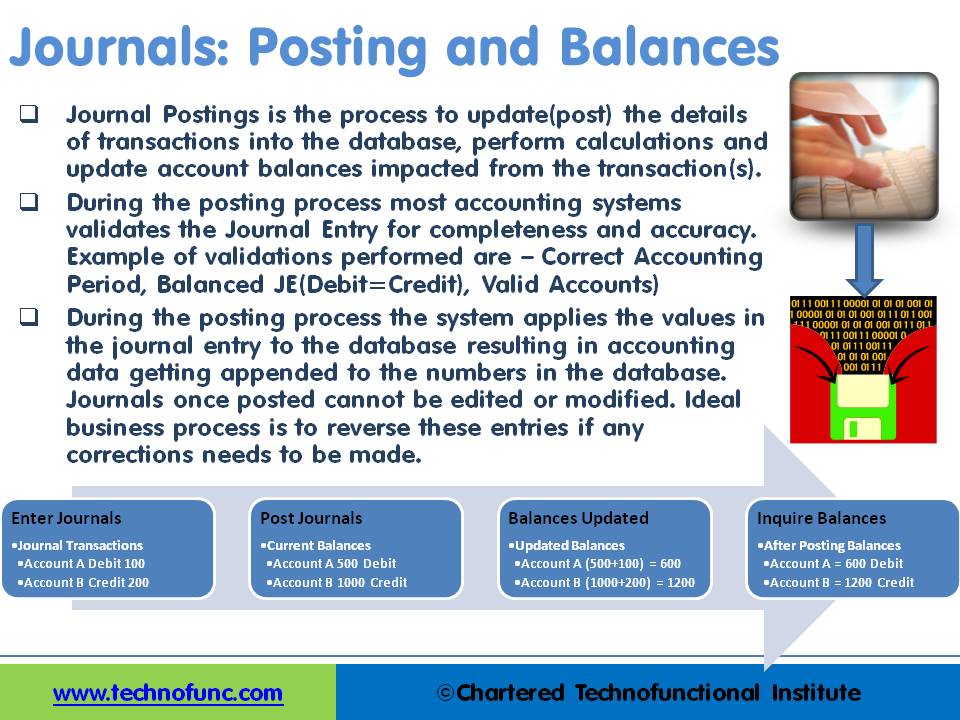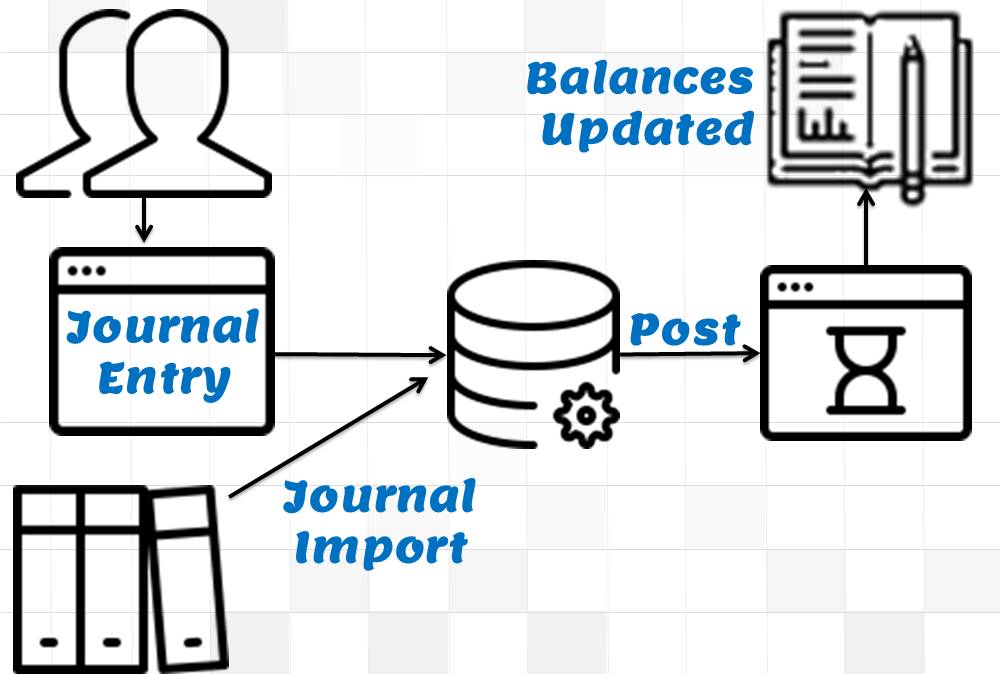- Home
- Business Processes
- Industry Knowledge
- Aerospace Industry
- Automotive Industry
- Banking Domain
- BFSI Industry
- Consumer/ FMCG Industry
- Chemicals Industry
- Engineering & Construction
- Energy Industry
- Education Domain
- Finance Domain
- Hospitality Domain
- Healthcare Industry
- Insurance Domain
- Retail Industry
- Travel and Tourism Domain
- Telecom Industry
- Leadership Skills
- eLearning
- Home
- Business Processes
- General Ledger (Record to Report)
- GL - Journal Posting and Balances
GL - Journal Posting and Balances
In this tutorial, we will explain what we mean by the posting process and what are the major differences between the posting process in the manual accounting system compared to the automated accounting systems and ERPs. This article also explains how posting also happens in subsidiary ledgers and subsequently that information is again posted to the general ledger.
What is Journal Posting?
As we discussed in the preceding tutorials, a transaction is first recorded in a journal. The journal is a chronological listing of the accounting events. Periodically, the journal entries are transferred to the accounts in the ledger. An organization's ledgers contain each and every account the organization uses, organized by account code. The final step of the bookkeeping phase is, posting to the general ledger. The process of transferring the debits and credits from the journal entries to the accounts is called posting. The ledger is a history of transactions by account. The purpose of posting is to maintain and be able to determine the balance of each specific account.
In practice, businesses use a variety of formats for recording journal entries. The journals may be part of either a manual accounting system or a computerized accounting system. The posting of a journal entry to a ledger account is a straightforward process. Posting transfers information already in the journal, requiring no further analysis. Remember, the key information in the ledger is the same as what's in the journal. The date, description, account names, account codes, and debit and credit amounts are all there in the ledger account, just in a different format.
Posting – Process Difference between Manual and Computerized Accounting Systems:
Manual Accounting Systems: As discussed earlier the preceding steps in the accounting cycle are to identify and analyze the transaction and record by making journal entries. Each single-line journal entry affects two ledger accounts. A typical bookkeeping process records transactions chronologically to a journal, posts daily to subsidiary ledgers, and posts periodically to the general ledger. After posting the transaction to the general ledger, you return to the journal entry and put in the reference number of each ledger account affected by the debit and credit. This indicates to anyone looking at the journal that the entry has been posted to the ledger.
Automated Accounting Systems: In automated accounting systems posting can be understood as the process to update (post) the details of transactions into the database, perform calculations and update account balances impacted by the transaction(s). During the posting process, most accounting systems validate the Journal Entry for completeness and accuracy. Example of validations performed are – Correct Accounting Period, Balanced JE (Debit=Credit), or Valid Accounts

Posting in Automated Systems:
During the posting process, the system applies the values in the journal entry to the database resulting in accounting data getting appended to the numbers in the database. Journals once posted cannot be edited or modified. The ideal business process is to reverse these entries if any corrections need to be made. To verify accounts, total balances from subsidiary ledgers are compared to the totals in each general ledger account.
In the example shown in the figure, in the first step, the journals are entered. Once the journals are entered, they are available in the systems for Review, Approval, and Posting. At this point, current balances in the accounts are not impacted. The next three boxes depict that as the journal gets posted, the current balances are updated to show the impact of the entered transaction. Hence posting is the process to update account balances with the transaction amount.
Posting from Subsidiary Ledgers:
As discussed in earlier tutorials, it is common for businesses to use subsidiary ledgers to track information with similar characteristics. The number and types of subsidiary ledgers and the level of detail contained in each varies substantially with the needs of the organization. There are many possible subsidiary ledgers as explained in examples on subsidiary ledgers article. At the end of a given period – such as a week or a month – the sub-ledger journal information can be posted to the ledgers in summary form, making the process of posting more efficient. Posting to subsidiary ledgers in addition to the general ledger is a good option for when more detail is required.
The relationship between journals, subsidiary ledgers, and the general ledger is slightly more complex than that between general ledger journals and general ledgers. Each subsidiary journal has entries that share the same characteristics, but the listing still reflects changes to two or more accounts in the general ledger. Subsidiary ledgers correspond to the control accounts in the ledger, the journal transaction is entered in sub-ledgers first, usually on a daily basis. Subsequently, these also get posted from the sub-ledgers to the general ledger, usually weekly or monthly.
The general ledger control account balances are checked against the totals in the subsidiary ledgers to ensure correctness at the end of the accounting period. To verify a subsidiary ledger such as the Accounts Receivable ledger, you begin by calculating the sum of the accounts with balances in the subsidiary ledger. You then compare that to the running balance in the accounts receivable control account of the general ledger. If the totals match, you can assume that the ledgers are accurate.
Related Links
You May Also Like
-
Prepayments and Prepaid Expenses
Prepayments are the payment of a bill, operating expense, or non-operating expense that settle an account before it becomes due. Learn the concept of prepaid expenses. Understand the accounting treatment for prepaid expenses. Understand the concept by looking at some practical examples and finally learn the adjusting entry for these expenses.
-
General Ledger - Advanced Features
Modern automated general ledger systems provide detailed and powerful support for financial reporting and budgeting and can report against multiple legal entities from the single system. These systems offer many advanced functionalities right from journal capture to advanced reporting. This article will provide an overview of some advanced features available in today's General Ledgers.
-
GL - Journal Posting and Balances
In this tutorial, we will explain what we mean by the posting process and what are the major differences between the posting process in the manual accounting system compared to the automated accounting systems and ERPs. This article also explains how posting also happens in subsidiary ledgers and subsequently that information is again posted to the general ledger.
-
Multi Currency - Functional & Foriegn
Currency is the generally accepted form of money that is issued by a government and circulated within an economy. Accountants use different terms in the context of currency such as functional currency, accounting currency, foreign currency, and transactional currency. Are they the same or different and why we have so many terms? Read this article to learn currency concepts.
-
Trial Balance in General Ledger
One of the greatest benefits of using a double-entry accounting system is the capability to generate a trial balance. What do we mean by trial balance? As the name suggests a trial balance is a report that must have its debits equals to credits. Understand the importance of trial balance and why it is balanced. Learn how it is prepared and in which format.
-
When the quantum of business is expected to be moderate and the entrepreneur desires that the risk involved in the operation be shared, he or she may prefer a partnership. A partnership comes into existence when two or more persons agree to share the profits of a business, which they run together.
-
GL - Different Accounting Methods
The accounting method refers to the rules a company follows in reporting revenues and expenses. Understand the two common systems of bookkeeping, single, and double-entry accounting systems. Learners will also understand the two most common accounting methods; cash and accrual methods of accounting and the advantages and disadvantages of using them.
-
As the business grows, the company may want to transition to a branch structure as branches are allowed to conduct a much broader range of activity than representative offices. Branches can buy and sell goods, sign contracts, build things, render services, and generally everything that a regular business can do. A company expands its business by opening up its branch offices in various parts of the country as well as in other countries.
-
In some of the ERP tools, there are more than 12 accounting periods in a financial year. This article discusses the concept of accounting calendar and accounting periods. Learn why different companies have different accounting periods. Understand some of the commonly used periods across different organizations and the definition & use of an adjustment period.
-
In this article we will help you understand the double-entry accounting system and state the accounting equation and define each element of the equation. Then we will describe and illustrate how business transactions can be recorded in terms of the resulting change in the elements of the accounting equation.
Explore Our Free Training Articles or
Sign Up to Start With Our eLearning Courses

About Us
Learning
© 2023 TechnoFunc, All Rights Reserved









